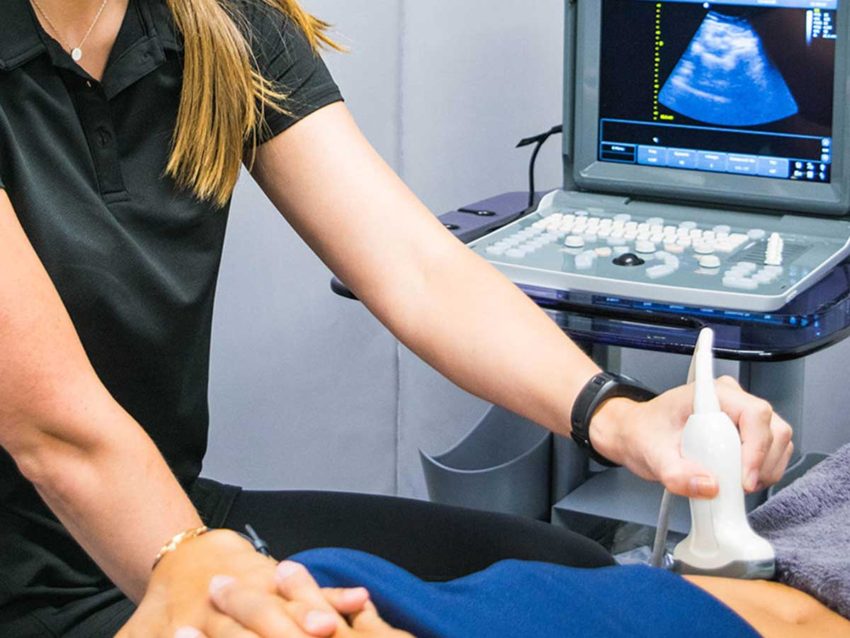If you’re looking for an ultrasound near you, then look no further! Ultrasound is a painless, non-invasive imaging modality that doesn’t use ionizing radiation. Below we will discuss everything you need to know from finding an ultrasound, the cost, the prep, and FAQs. I will also share my experience with the ultrasound near me.
Map of Ultrasound Near Me
For “Ultrasound Near Me”, see the map below…
What is an Ultrasound?
An ultrasound is a medical test that uses sound waves to create pictures of organs and structures inside the body. These exams do not use ionizing radiation (as used in x-rays) and are generally considered safe for all patients, including pregnant women and their unborn babies.
How Does an Ultrasound Work?
At its simplest, an ultrasound scan uses a transducer (probe) that emits high-frequency sound waves and picks up the echoes as they bounce off structures in the body.
The transducer is usually systematically moved over the skin surface, allowing the sonographer to take “slice by slice” images of the area being examined. Ultrasound imaging is often used to visualize soft tissues that do not show up well on x-ray images.
What Can Ultrasound Be Used For?
Ultrasound is often used to visualize organs and structures within the body such as the heart, kidneys, liver, pancreas, bladder, uterus (womb), ovaries, fetus (during pregnancy) and more. It can also be used to measure blood flow and blood vessel diameters.
This is also used in physical therapy and rehabilitation to provide diagnostic information about muscles, tendons, and joints. It may also be used to guide needle placement during biopsies or other procedures. It is also a common alternative to a DEXA scan for bone density to determine the risks for osteoporosis.
Ultrasound as an Alternative to DEXA Scans
Ultrasound is a painless and non-invasive alternative to DEXA scans for measuring bone density.
It uses sound waves to measure the speed of sound as it travels through bone, which is then used to calculate bone density. The exam is generally considered to be as accurate as DEXA scans for measuring bone density in the extremities (hands, feet, etc.), and it does not involve ionizing radiation.
This exam is also a good option for people who are unable to have a DEXA scan due to metal implants or other reasons.
What are the Benefits
Ultrasound is a painless, non-invasive alternative to x-ray imaging. It does not use ionizing radiation, which makes it a good choice for pregnant women and their unborn babies. It is also generally less expensive than other imaging modalities such as MRI or CT scans.
What are the Risks
There are no known risks associated with the imaging technology. It is considered safe for all patients, including pregnant women and their unborn babies.
How Much Does an Ultrasound Cost?
The cost varies depending on the type of exam and the facility where the exam is performed. These exams are generally less expensive than other imaging modalities such as MRI or CT scans.
Does Insurance Cover an Ultrasound
Most insurance plans will cover the cost if it is considered medically necessary. It is always best to check with your insurance provider to verify coverage before having the exam. In the case of a bone density scan, it is typically covered and will require a referral from a doctor.
How to Prepare for an Ultrasound
There is no special preparation required for most ultrasound exams. You may be asked to drink water or other fluids to fill up your bladder so that it can be seen more clearly on the monitor. You may also be asked to remove clothing and jewelry in the area being examined.
What Happens During an Ultrasound?
You will be asked to lie down on a bed or exam table. A clear gel will be applied to the skin in the area being examined. The gel helps to conduct the sound waves and provides a barrier between your skin and the transducer.
The Scanning Process
The sonographer will then move the transducer over your skin to visualize the structures underneath. The transducer emits sound waves that bounce off of structures in your body and are then picked up by the transducer. These sound waves are then converted into images that can be seen on a monitor.
After the Exam
After the exam, you will be able to get dressed and go about your day as usual. There are no side effects or risks associated with this form of imaging. Your test images will be sent to the doctor who ordered the exam for interpretation.
Your doctor will discuss the results with you at your follow-up appointment.
Where to Find an Ultrasound Near Me
If you are looking for an ultrasound near you, use our search tool to find a facility in your area. These exams are generally performed in outpatient imaging centers or hospitals. Most ultrasound exams do not require a referral from a doctor.
Bone density scans may require a referral from your doctor. You can typically find a facility that offers bone density scans in your area by searching for “bone density scan near me” or “ultrasound for bone density near me.”
Ultrasound Near Me – Conclusion
Ultrasound is a painless, non-invasive imaging modality that does not use ionizing radiation. It is generally less expensive than other imaging modalities such as MRI or CT scans. This type of imaging is considered safe for all patients, including pregnant women and their unborn babies.
Most insurance plans will cover the cost if it is considered medically necessary.
There is no special preparation required for most exams. The exams are generally performed in outpatient imaging centers or hospitals. The images will be sent to the doctor who ordered the exam for interpretation. Your doctor will discuss the results with you at your follow-up appointment. That’s what I have learned from the place that does ultrasound near me.
